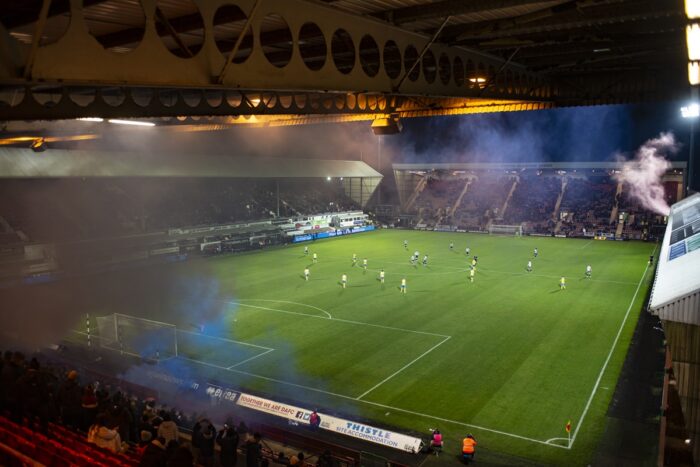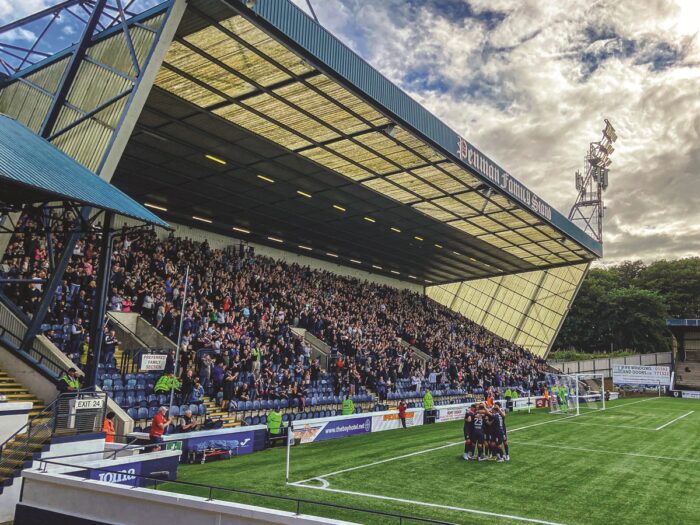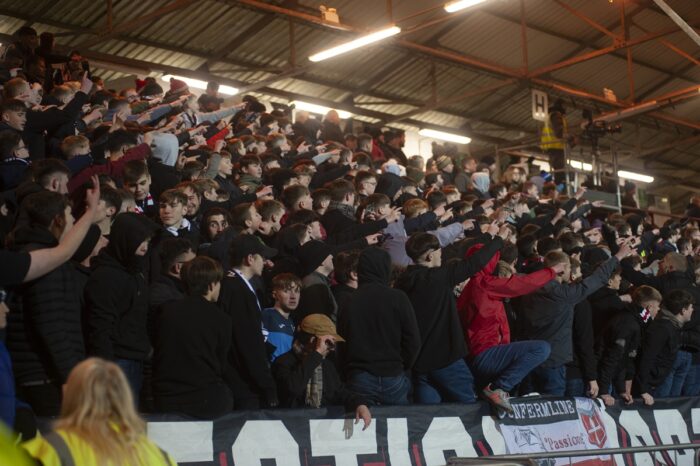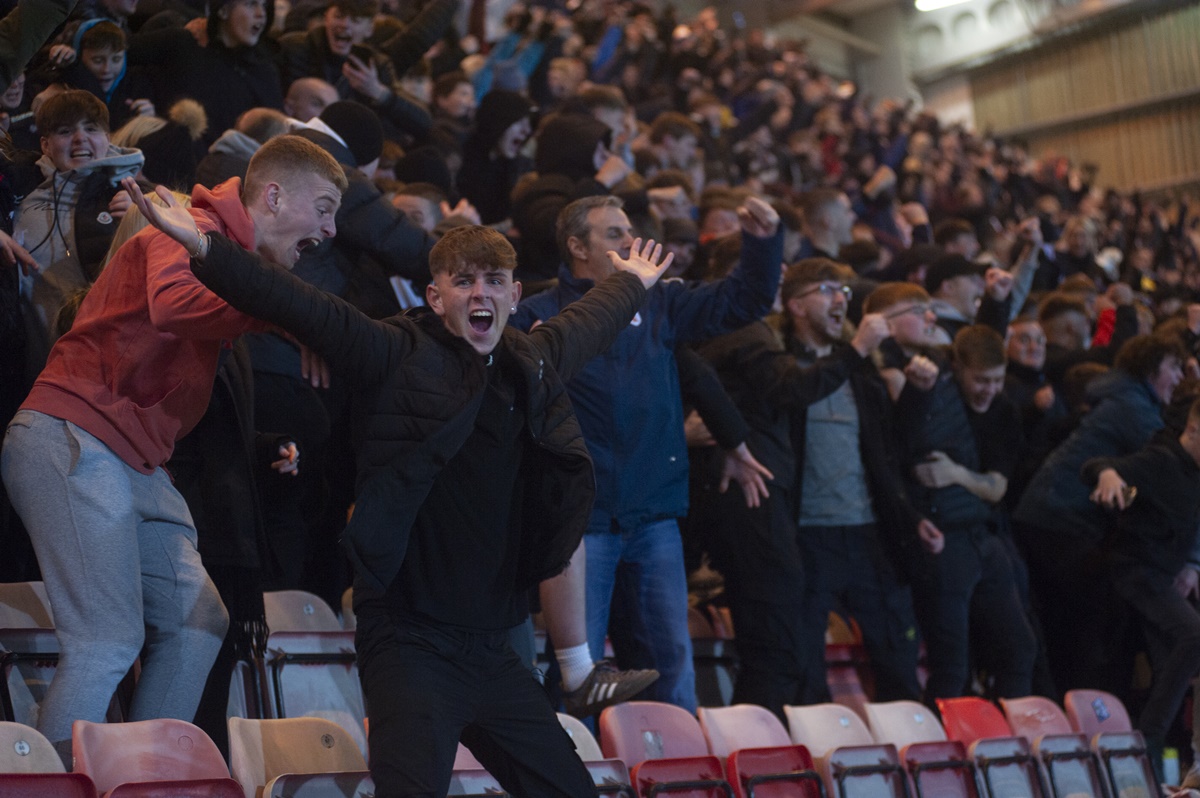Season 2023-24 has not exactly been a golden era for the great Scottish football derby.
Glasgow and Edinburgh’s derbies remain as big and bad-tempered as ever, but elsewhere, from Tayside to Ayrshire, Renfrewshire, Lanarkshire and the Highlands, the vagaries of the pyramid system have put a swathe of our finest regional rivalries into hibernation. Dundee and Dundee United do not currently share a division, and neither do Kilmarnock and Ayr United, St Mirren and Morton, Inverness and Ross County or any combination of the four Lanarkshire clubs.
It leaves us with a severe drought of cult heroes, pantomime villains, internet vendettas and intensely localised petty debate about which one is ‘the wee team.’ All the things that make this kind of fixture special, basically. So thank God for Dunfermline Athletic and Raith Rovers.
The Fife Derby has always mattered within the confines of the Kingdom, but from the outside has sometimes felt like one of those long-running foreign conflicts which go strangely unreported in the West – or the west of Scotland, in this case. At times in recent years the fixture has appeared to be in terminal decline, with the clubs taking turns to languish down in League One and both too preoccupied with their own problems to worry much about what was going on 15 miles down the road.
This season, all that has changed, to such an extent that what was once a parochial dispute between two equally dysfunctional neighbours can now legitimately claim to be the third biggest active derby in the country. When the final whistle goes at Stark’s Park this Saturday afternoon, Raith and Dunfermline will have clashed six times across three different competitions this term, with the average attendance from the three league meetings so far currently standing at over 7,000. All five derbies have been fierce, frenetic and dramatic – albeit a touch too one-sided for the liking of Pars admirers.

Raith’s 3-0 Scottish Cup win at East End Park in November 2023.
On one hand, the explanation for this explosion of interest in the Fife Derby is simple. Following Dunfermline’s swift return as champions from a one-season stay in League One, the two clubs are once again occupying the same division, and both have a hell of a lot to play for in this year’s Championship.
Ian Murray’s Rovers – as discussed in the cover feature of Nutmeg 31 – are surprise title contenders thanks to Murray’s gung-ho tactics and the transformative influence of the consortium that bought the club last summer. Meanwhile, James McPake’s youthful Pars are (despite the unrelenting injury crisis that has plagued them for most of the campaign) firmly in play-off contention. For the first time since Dunfermline prevailed over Raith in the 2010-11 First Division title race, every meeting is freighted with extra significance. But it’s also true that this fixture is a big deal again because senior figures at both clubs have consciously made an effort to make it one.
Having faced pariah status two years ago, Raith Rovers are now emerging as the fastest-growing club in the country, propelled by the success of ‘Murrayball’ and a raft of late victories. Could this signal the dawn of a new golden age in Kirkcaldy?
Read Scott Fleming’s special feature in Nutmeg 31 – out now
“I think the derby had kind of become a non-event in the last few years,” former Dunfermline striker and current Raith CEO Andrew Barrowman tells Nutmeg. “Dunfermline didn’t really care about Raith Rovers, the so-called derby with Falkirk had become more important to them. And we’ve got great respect for them, our board and their board are friends off the pitch, they’re a great club and do lots of things well.
“But we just wanted to make it a proper derby again, get people talking about it and wanting to come along. Dunfermline came in huge numbers to our place, we went in huge numbers to their place, and both clubs are benefiting from that financially. Playing six of them this season is either good luck or bad luck depending what way you want to look at it… but it’s just been great to make it an event again.”
When the first competitive meeting took place in the Viaplay Cup group stage, on a sunny Kirkcaldy afternoon in July of last year, the sides played out a 1-1 draw followed by a penalty shootout won 4-2 by the Pars. Dunfermline youngster Matty Todd slotted the winning spot-kick and celebrated by sticking his fingers in his ears and goading the Raith fans behind the goal. You’d have to be a particularly churlish member of the Celebration Police to grudge a young player making the most of something like that, but it has nonetheless proved to be a fateful moment, and something of a tone-setter for the tension that’s been simmering away between the two sets of fans, coaches and players ever since.

Raith celebrate in front of their fans during the Viaplay Cup group game in July 2023.
Raith have been the undisputed kings of Fife since that day, beating Dunfermline three times on league duty and dumping them out of the Scottish Cup with a 3-0 win at East End Park, broadcast live on national telly last November. Exasperatingly for DAFC supporters, Scottish Cup shellacking aside they have been competitive in every one of the games, creating as many chances as Murray’s side, but lacking that clutch ability to deliver in big pressure moments which has been Raith’s trademark all season long.
“The derbies have been a microcosm of the campaign,” says journalist, Dunfermline fan and host of the ‘That’s Never 10 Yards’ podcast Michael Wood. “The team has looked competent from the back to the final third – even with all the chopping and changing of personnel through a horrendous injury spell that has never abated – but what the club has been missing, ever since the sale of Kevin Nisbet really, is that coveted goal-scorer which the likes of Dundee United (Louis Moult) and Raith (Lewis Vaughan) possess.”
In the many Raith goal celebrations that Dunfermline fans have had to sit through during this reign of terror, the fingers-in-ears gesture has been a recurring theme. And there was more surreal comedy after Rovers’ 1-0 victory at Stark’s Park in October, when McPake accused Murray of over-celebrating Sam Stanton’s 93rd-minute clincher. “Good luck to them but I’d certainly be disappointed in my staff if that was the way they behaved,” was the former Dundee boss’ somewhat salty post-match verdict, with Murray breezily retorting that there was “nothing in it.”
Even in the transfer market Raith have haunted Dunfermline’s every step, swooping in three times to sign players from Dundee on loan, all three of whom had been linked with a move to East End Park. This campaign of psychological warfare has been aided and abetted by the social media team at San Starko, which has never knowingly missed a chance to twist the knife. One example came last month on X, when they celebrated the club’s momentous 2-1 win over title rivals Dundee United with a graphic of a cartoon race, which depicted Raith’s go-kart poised to overtake United’s, and somewhere way behind in the distance, a little Dunfermline go-kart disintegrating in a ball of flame. Petty? Perhaps. Unprovoked? Almost certainly. Yet it’s also an essential part of what’s made the Fife Derby such a box office smash this season.
FT: Raith Rovers 2-1 Dundee United.
We close the gap to just one point.#YouBelong pic.twitter.com/SGhAibPm55
— Raith Rovers Football Club (@RaithRovers) February 16, 2024
“We’ve had a bit of fun on social media, and none of it is meant to be disrespectful to Dunfermline or any other club,” states Barrowman. “We just want to put bums on seats and get the fans really looking forward to the next derby. Football’s meant to be fun. It’s a business and it has to be serious to an extent, but sometimes you forget to enjoy it. Some of the stuff we’ve done might come back to bite us, but we’ll take it on the chin – that’s what it’s all about and we kind of welcome that. We would hope that other clubs get onboard with it, because it makes Scottish football as a product a lot stronger and more marketable.”
Even Dunfermline fans like Michael can concede the strategy has paid off so far.
“Evidently, Raith’s approach to social media under the new ownership has galvanised the fanbase, helped improve the relationship with the support which fractured after the David Goodwillie signing and, most importantly for them, brought more bodies back in through the door. It’s refreshing to see a club not take themselves all too seriously and try and get a reaction, as long as they can accept the flak when it blows back in their faces – which hopefully, on Saturday, it does!”
The renewed passion for this fixture has also occasionally manifested itself in less good-humoured ways. There were running battles between fans in Kirkcaldy town centre before the game in October, and the New Year derby at East End Park was marred by a widely reported incident where teenage Raith fan Kieren Ross was assaulted by a group of Dunfermline fans who have since been arrested and served with stadium banning orders by the club.
With young supporters at the centre of both incidents, it presents the two clubs with a slightly tricky dilemma. Both have made concerted efforts to encourage the younger demographic and their forays into the world of ultra culture, and have reaped the benefits in the form of bigger crowds and enhanced atmospheres. Dunfermline’s ‘Section North West’ are renowned for their impressive tifo displays, while Raith have successfully trialled a new singing section in the South Stand. According to Barrowman, continued engagement is the key.

Both clubs have found success attracting younger fans.
“For any club, derby or otherwise, you’re always going to have idiots who want to go to a game of football and have a fight, and it’s hard to prevent that. But for our part we have met with the fan groups and the ultras, and we’ll help them and resource them, but they’ve got to give a little back and represent the club how we want them to. So we’re actively engaging with them, and I know Dunfermline have done that too with Section North West, which has been a huge success.
“These ‘young teams’ will always annoy certain people but what they do is bring noise and colour to the game, and you see it in other European countries where it’s a big part of their football culture.
“I think as clubs we’ve got a responsibility to bring these groups in as part of the team, rather than just bastardising what they do and pushing them away, because that’s not going to work. You look at Falkirk this season and the goal celebrations – the players all run straight to the ultras, they love it because it brings a better atmosphere. The incident with Kieren, that was just some fans who got carried away with the emotion in the moment – probably alcohol-fuelled I would imagine – and made a mistake, but that doesn’t represent Dunfermline as a club.”
“Section North West is let down by a few individuals at times, but for the most part the passion they bring with their nonstop singing gives a lift to the rest of the stadium,” adds Wood. “I’ve been to all the derbies this season except the televised League Cup one – preferring to watch it in a beer garden on a rare Scottish summer’s day! – and the atmosphere has always been heated but healthy and jovial.
“What happened to Kieren was simply unacceptable and inexcusable. If you are a supporter of the club, the last thing you should want to do is embarrass it on a national scale.”
More to come?
The intriguing question is whether we’ll have more of these derbies to look forward to next season. Part of Dunfermline’s motivation for Saturday is surely that they can deal a huge blow to Raith’s title hopes with a win; yet on the flip side, the gap between the play-off spots and ninth place is so narrow that defeat for the Pars could leave them perilously close to a relegation playoff.
And what if derby number six isn’t actually the last of the season? If Raith DON’T win the title, and Dunfermline DO sneak into the top four, then we could have Fife Derbies #7 and #8 to look forward to in the semis of the Scottish Premiership play-offs. One can only imagine what Raith’s social media team would cook up for that one…




